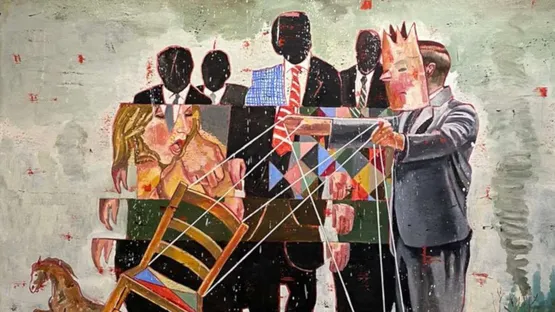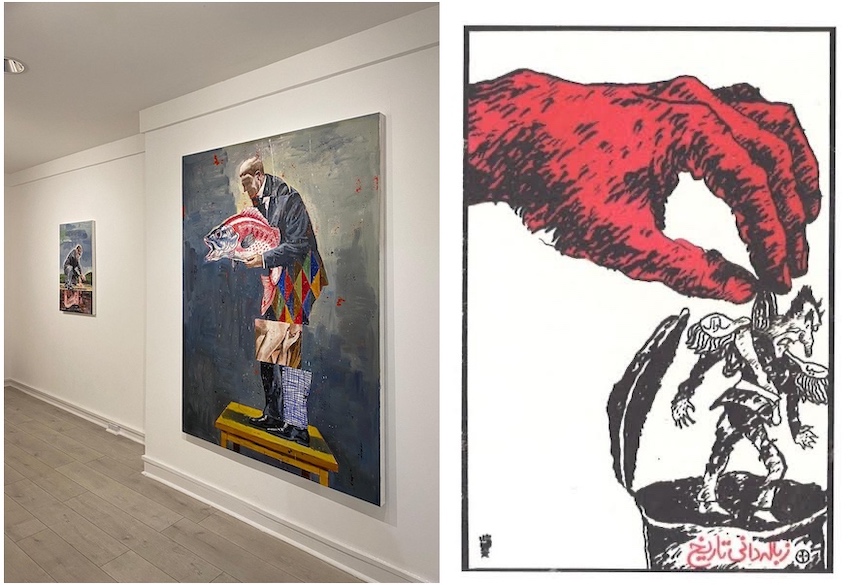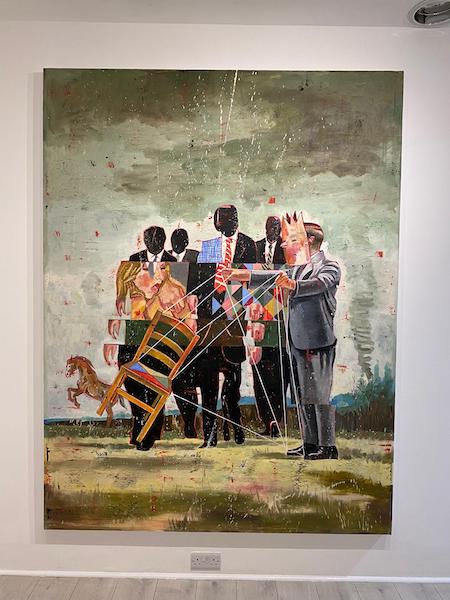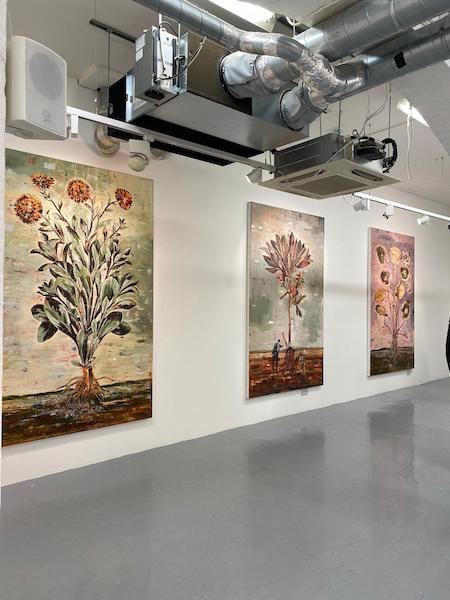
Nicky Nodjoumi / Nikzad Nodjoumi
Philip Guston Now has become Philip Guston later, Nicky Nodjoumi (recently named among the "the 25 most influential works of American protest art since World War II" by New York Times) fortunately had two solo shows in London; one exhibition at Noho Studios, 46 Great Titchfield St, and another at the Taymour Grahne Projects, 10 Portland Road.
Nicky Nodjoumi is an Iranian-born American painter currently working and living in Brooklyn. Following his graduation in Fine Arts at the School of Fine Art at Tehran University, 1961, he moved to the USA and received his Master’s degree in Fine Arts from The City College of New York in 1974. During this time he cooperated with the CISNU (Confederation of Iranian Students National Union) to create political posters demanding freedom of speech for Iranian people back home. Nicky’s curiosity for politics wasn’t limited to Iran; he also participated in demonstrations against Vietnam War and similar causes, producing significant posters like. Nicky dropped painting for two or three years to become a full-time political activist in that period. It seems that he has concrete priorities when deciding between personal or collective interests. He returned to Iran in 1975 which instantly put him in trouble with the Pahlavi’s intelligence service known as SAVAK. He was interrogated for three months which resulted in a ban from teaching at any school. He left Iran again briefly before returning in 1978 to join the revolution.

Cultural Revolution
In an interview with Kambiz Hosseini in 2013, Nodjoumi was questioned about his solidarity with the revolutionaries back in 1979. After replying a straight 'I wasn’t a fan of Khomeini' Nodjoumi went on to explain it was possible to take down Pahlavi’s regime by allying with Khomeini and his elite, but no one could even comprehend Khomeini would succeed due to the people’s democratic demands and values at the time of the revolution. Yet it wasn’t long until Nodjoumi permanently left Iran in 1981, just three years after his return. He was exiled when the Cultural Revolution was executed under the shadow of the Iran-Iraq war, a series of events that led to universities being temporarily closed and the violent purging of a wide spectrum of political organizations opposing Khomeini.
In the hostile environment of the Cultural Revolution, Nodjoumi dared to be a dissident. In a sense, the painter’s persona, as a figurative painter, has a lot in common with the Persian myth of Shahrzad, the storyteller of the One Thousand And One Nights. Michel Foucault’s Death of the Author essay says Shahrzad ‘spoke, telling stories into the early morning, in order to forestall death, to postpone the day of reckoning that would silence the narrator.’ Nodjoumi’s political and artistic endeavors, specifically in his painting career, could be interpreted as an attempt to salvage intellectualism, modernism and the democratic ideals of the revolution, proving that 1979 was not a reactionary recessive movement. The storyteller works with memories as their basic materials, which ‘creates the chain of tradition’ and ‘passes a happening from generation to generation’ as Walter Benjamin writes in his reflective essay The Storyteller. Therefore it is possible to interpret Nodjoumi’s figurative paintings as dramatic scenes, produced to hand over political and social collective memories, perhaps also as pieces of advice, to prevent the rise of another Khomeini.

Pornography of Politics
The Approaching Masked Carnival painting is a 216x165cm oil painting that held my attention more than any other painting in the show. Nodjoumi’s paintings are expressive, dynamic, dramatic, figurative, and large-scale. This specific painting depicts a strange scene in a storm, occurring at the edge of the forest and dominated by defaced men in suits, busy with nonsensical activities. The figures are constructed from mismatching legs and bodies glitching into a pornographic scene. They don’t give away their intentions, it’s not clear what is happening. The actions include a man in a chicken-mask performing a strange magic trick with the chair, which appears absurd and cultish. Webster’s New Collegiate Dictionary defines the Absurd as ‘a state, where man exists in an irrational and meaningless universe and in which human life has no meaning outside of his own existence’. In such a world, the very act of searching for meaning pushes the curious man into more unwanted conflict with his universe; perhaps that’s the space where Nodjoumi’s painting is happening; a constant struggle to find reason in a world sinking into madness. On the other hand, Neil Cornwell in The Absurd in Literature defines the absurd as a style which manifests a ‘timeless disposition or quality’. Therefore, it is also possible to perceive Nodjoumi’s painting as a reflective visual attempt to articulate the irrational political and social circumstance of his life between Tehran and New York. Nodjoumi’s work is inextricably linked to the political and social climates he observes; from protesting the Vietnam War, the regimes of Pahlavi and Khomeini, all the way to supporting the Green movement of 2009. Now he is observing yet another absurd situation; the American election of 2020, the Biden vs. Trump debate, and all the other episodes of this dark series, which could have been a comedy if they were fictional. But it is real and quickly unfolding into chaos. It’s no surprise to see Nodjoumi painting the backgrounds in grungy, wide brush strokes looking more like a concrete wall or perhaps an unwelcoming sky. All through the renaissance paintings were operating like a beautifully constructed lie, inviting you inside like a window but Nodjoumi’s paintings block your way. These paintings are like warning shots, refusing to invite you in, not a comfortable staged carnival but an irrational and absurd hoard that could march out any moment.

About Life, Growth and Wisdom
The amalgamation of calm and chaos; confidence men in uneven suits, with obscured faces or novelty masks, playing magic tricks during an imminent tornado disaster. It could be an illustration for the cover of Mark Fisher’s Capitalist Realism, suggesting a Nihilist sense of humor. Nodjoumi attempts to ridicule the men whose outfits remind us of politicians, bankers and generally people in power. The juxtaposition between the powerful men and their superstitious activities points out the shallow modernism of men in suits. Although there is a dark, hostile and absurd sense of humor in the painting, Nodjoumi’s work is far away from being nonsense or passive. According to Cornwell there is a clear line between nonsense and the absurd. Pointlessness as the point of nonsense is essentially non-serious; pointlessness as the point of the absurd is more serious. Nodjoumi paints about power and those that uphold it. Perhaps Nodjoumi’s long history with painting and political activism proves his seriousness in exhibiting the fragility of the men in power. This seriousness is essential for understanding the absurd, which has strong ties to the social and political commitment. Absurd doesn’t mean the existent has purposelessly has resigned and disconnected from the reality. In existential thought, resignation does not primarily refer to a disengagement from social and political commitments insofar as they relate to outer rather than inner determinations of thought. Resignation more adequately designates what seems to be the only sensible attitude when man comes to confront the implacable truth of human mortality. However, accepting the mortality comes with the responsibility of protecting it, at least for an existentialist. No wonder why the most repeated motif in the exhibited paintings is the diagrammatical depiction of plants. According to Dr. Bahram Beyzai’s lectures at the Stanford University titled the ‘Semiotics of the Iranian Myths’, the fundamental idea of Iranian mythology evolves around the two elements of water and soil. When these two elements join together we will witness life, growth and finally wisdom. Therefore separating the two is an existential threat. Nodjoumi’s paintings of diagrammatical images of plants show his deep concern of our fragile existences.

Bearing The Cross
Although Nodjoumi is socially and politically conscious, as we can see from his talks and opinions in interviews, painting the absurd and absurdity cannot be reduced to just the awareness of a particular state of affairs, it goes beyond that and turns into a call to action. The quick grungy brushstrokes of the background and paint drips at the bottom of the painting are technically used to emphasize the urgency and priority of this action. Nodjoumi has been revolting the surrounding irrationality through continuity, not resignation. A good example of such behavior is the figure of Sisyphus, from Albert Camus ‘The Myth of Sisyphus’, revolting against absurdity by continuously practicing the punishment. In the same way, Nodjoumi’s non-stop painting career over the past decades, all through the worst circumstances, is an act of protesting the established unreasonableness and absurdity. Such sustained persistency proves that the painter finds painting an act of co-operating with life without being able to come to terms with it.
While there is a certainty manifested by the facial features, gestures and firm actions of the figures, the painting doesn’t jump to conclusions to dictate anything. At the end of the day, the painting could be interpreted differently, which is why Nodjoumi is not a propagandist. The painting makes every effort to open the mind, which is the basic difference between Nodjoumi and an agitprop maker. This way he respects the intelligence of his audience and he is genuinely concerned about the development and education of the individuals. An educator would be pleased to see others thinking on their own. For that reason, Nodjoumi has been seriously committed to the democratic values of the revolution of 1979, finding reason and confronting absurdities threatening our existence. After all, we all know "the lack of reason produces monsters".
Text by Parham Ghalamdar
Featured image: Nicky Nodjoumi - Approaching Masked Carnival (installation view, detail). Photo credits Malihe Zafarnezhad
Installation view images were photographed by Malihe Zafarnezhad
Can We Help?
Have a question or a technical issue? Want to learn more about our services to art dealers? Let us know and you'll hear from us within the next 24 hours.
